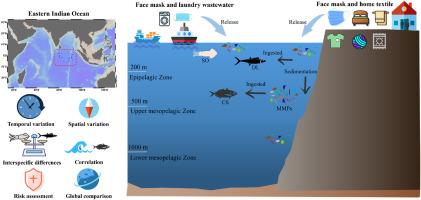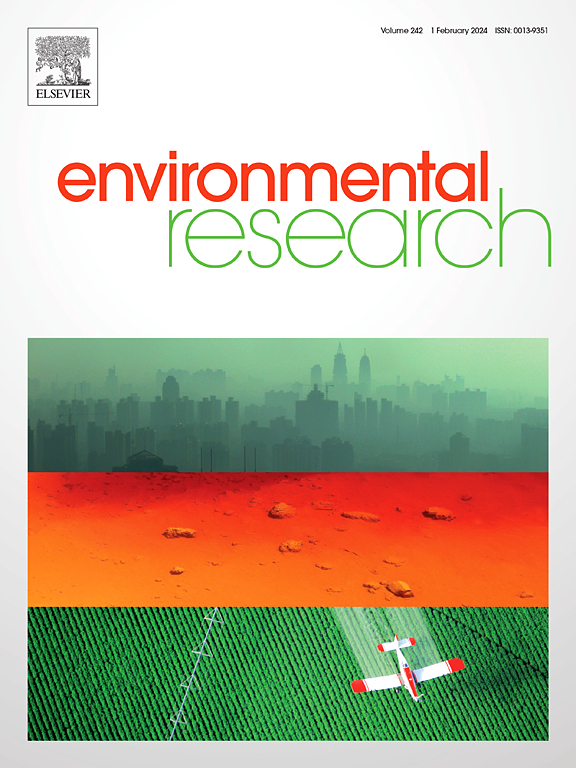东印度洋地表水和浮游生物中的微观和中观污染:时空变化、相关性和风险评估。
IF 7.7
2区 环境科学与生态学
Q1 ENVIRONMENTAL SCIENCES
引用次数: 0
摘要
人们对东印度洋(EIO)的微整形和中整形(MMP)污染仍然知之甚少。本研究发现,2022 年东印度群岛浮游动物体内的 MMP 丰度(平均:2.30 ± 0.39 个/1 和 1.81 ± 0.54 个/g-1)明显高于 2021 年(平均:1.60 ± 0.22 个/1 和 0.80 ± 0.13 个/g-1)。相比之下,地表水中的 MMP 丰度在 2021 年(平均值:0.04 ± 0.01 项 m-3)和 2022 年(平均值:0.05 ± 0.02 项 m-3)之间变化不大。从 2021 年到 2022 年,主要聚合物--聚丙烯(PP)、人造丝(RA)和涤纶(PES)--在浮游生物中的含量上升,这可能表明沿海地区的口罩和家用纺织品污染加剧。东北部和东南部地区之间的聚丙烯(PP)和人造丝(RA)的显著空间变化仅在泥鳅中观察到,这表明与地表水相比,它们是MMP时空变化的更好指标。与紫背飞乌贼和鲭鳞相比,影流鱼摄取了更多的MMP,这可能是由于其栖息地较深的缘故。通过同时考虑颜色、成分和形状,综合MMP分析表明,地表水中的MMP污染与近海生物之间的相关性不明显,这表明近海生物可能通过地表水以外的多种途径摄入MMP。在全球范围内,地表水和泥鳅的风险指数达到了中上水平,这强调了在 EIO 进行持续监测的必要性。环氧树脂、橡胶和聚丙烯+丙烯酸酯被确定为危害最大的聚合物,为制定有效的塑料污染缓解战略提供了宝贵的依据。本文章由计算机程序翻译,如有差异,请以英文原文为准。

Micro– and mesoplastic pollution in the surface water and nekton from the eastern Indian ocean: Spatiotemporal variation, correlation and risk assessment
The pollution of micro– and mesoplastic (MMP) in the Eastern Indian Ocean (EIO) remains poorly understood. The present study revealed that MMP abundance in nekton from EIO in 2022 (mean: 2.30 ± 0.39 items individual−1 and 1.81 ± 0.54 items g−1) was significantly higher than that in 2021 (mean: 1.60 ± 0.22 items individual−1 and 0.80 ± 0.13 items g−1). In contrast, MMP abundance in surface water varied insignificantly between 2021 (mean: 0.04 ± 0.01 items m−3) and 2022 (mean: 0.05 ± 0.02 items m−3). The rise in predominant polymers—polypropylene (PP), rayon (RA), and polyester (PES)—in nekton from 2021 to 2022 may suggest increased pollution from face masks and home textiles along coastal regions. Notable spatial variation in PP and RA between the northeastern and southeastern regions was observed only in nekton, suggesting they are better indicators of MMP spatiotemporal variation than surface water. Shadow driftfish ingested more MMPs than purpleback flying squid and mackerel scad, likely due to its deeper habitat. By simultaneously considering color, composition, and shape, integrated MMP analysis showed insignificant correlation between MMP pollution in surface water and nekton, suggesting that nekton may ingest MMPs through multiple pathways beyond surface water. Risk indices for surface water and nekton reached moderate to upper levels globally, emphasizing the need for continued monitoring in the EIO. Epoxy resin, rubber, and PP + acrylic were identified as the most hazardous polymers, providing a valuable basis for developing effective strategies to mitigate plastic pollution.
求助全文
通过发布文献求助,成功后即可免费获取论文全文。
去求助
来源期刊

Environmental Research
环境科学-公共卫生、环境卫生与职业卫生
CiteScore
12.60
自引率
8.40%
发文量
2480
审稿时长
4.7 months
期刊介绍:
The Environmental Research journal presents a broad range of interdisciplinary research, focused on addressing worldwide environmental concerns and featuring innovative findings. Our publication strives to explore relevant anthropogenic issues across various environmental sectors, showcasing practical applications in real-life settings.
 求助内容:
求助内容: 应助结果提醒方式:
应助结果提醒方式:


